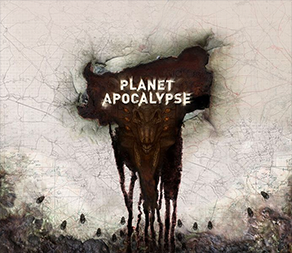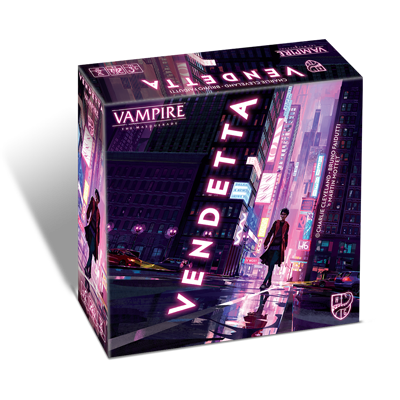Review copy provided by Horrible Guild
Alone is an asymmetric dungeon crawler designed by Andrea Crespi and Lorenzo Silva, with art from Steven Hamilton. It’s an atmospheric horror game from publisher Horrible Guild that underwent a second print run on Kickstarter. Accruing almost $350,000 from over 3,500 backers, the survival space epic has grown since its inception and has morphed into a pretty robust tabletop experience.
There’s a little bit of everything in this game. There is cooperative play… between the evil masterminds. There’s tile-laying and dungeon crawling… where the lights go out and you have to search and fight in the dark. There are miniatures. There are card decks. Players can play randomized scenarios or they can embark on a campaign.
Many players will be able to latch onto some aspect of Alone and discover a thrilling game of cat and mouse that awaits in a sci-fi setting that’s so culturally familiar.
STORY
If you’ve watched any classic sci-fi horror movies in the past, then Alone will feel like a sister story to these tales of survival and terror.
Humans in space. In a broken spaceship. Malfunctioning lights. And humans aren’t the only thing on board the dark and damaged vessel. What could go wrong?
Year 2417.
After the discovery of the ORCS space-contraction technology, that enables ad-hoc space stations to compress the vast emptiness of space, acting as a sort of “stargate” that allows ships to travel over the span of light-years in mere instants, humanity has been colonizing new planets for the last couple of centuries.
Many Earth countries have evolved into space-colonizing multi-planet powers. The Commonwealth, the Korean Federation, and the Portuguese Empire were among the first to set a stable foot outside of the Solar system, but in the last few decades, more countries have been expanding their space possessions, in a rush to take control of new, unexplored planets to mine for ore and water.
In the remote depths of space, the OICS Bravery, a Commonwealth ship of the fleet of the outer India Company, was shipwrecked on an unknown planet on its route to the Portuguese colony of Nova Maputo, in the Delta Corvi system. After the crash, a castaway member of the Bravery crew wakes up in an abandoned colony, ALONE. Unspeakable horrors lurk in the darkness, waiting. With no idea of the whereabouts of their crewmates, armed with only a few tools and their wits, this unintentional Hero will have to fight for their life.
Humans can accomplish great things when they work together. When they’re alone and monsters roam the hallways? The list of feasible accomplishments shrinks down to “not crying hysterically” and, maybe, “running away from the danger rather than headlong into it” if the human is resourceful enough.
And that’s what players set out to do. Discover what they are capable of when the chips are stacked against them.
GAMEPLAY
As I’ve mentioned already, Alone is an asymmetric game that challenges one player as the Hero to survive in a small window of time while they complete missions onboard a spaceship full of danger. The other player(s) will control the “evil” on the ship—everything that could pose a threat to the Hero.
Across a map full of traps, creatures, and the unknown, the Evil player(s) will relentlessly pursue the Hero until either the protagonist has completed two of their missions or the evil on the ship has overwhelmed the unfortunate crew member.
For the uninitiated, this is a weighty game with a lot of rules to juggle and a lot of actions (and reactions) to consider. And, technically, the Evil side doesn’t have a turn. The Hero is the one directing the course of the game by selecting actions to perform each turn until a round has been completed and the game inches closer to the end, for better or worse. But the Evil side plays “reactions” to movements, attacks, or other actions from the Hero.
Themed decks represent the Fury, Speed, Terror, and Traps of the enemies in the dark and the Hero must overcome all of these obstacles in order to survive.
At its best, Alone is a game of dueling players, armed with different weapons and strategies. The Hero must evade, explore, defend, and escape. The Evil must ensnare, endanger, scare, and scar.
One of the most thrilling aspects of the gameplay is the vast contrast in the information. The Evil has a full view of the map, the rooms, the location of monsters, and the position of the Hero. It’s all tucked away behind the game screen that blocks the Hero’s vision. The Hero, on the other hand, only has the Labyrinth, which is the ever-changing, constantly-disappearing set of tiles that mark the Hero’s progression on any given round. Move out of view of a certain hallway or leave a room in the dark and it will eventually return to the clutches of the Evil. Changing levels from one floor of the spaceship to the other? Well, all exploratory progress that was made is lost, save for whatever information you filed away on the Holowatch.
And each player’s mindset is so divergent from the other. I really like that contrast. As the Hero, a player will consider the advantages and disadvantages of moving quickly and recklessly versus slow and cautious. One might prevent loss of life or self-control throughout the game but the other will ensure that you finish your missions on time. As the Evil, players will need to determine if they’re going to brazenly unleash attack after attack on the Hero or if they’re going to bait them, lure them into a false sense of security before unraveling a chain of events that leads them to their doom.
So many other factors influence gameplay. The difficulty can be changed at the outset to affect the Hero’s starting condition. The layout of the map and the random selection of missions could make for a more breezy Hero adventure or a gut-wrenching journey through the Labyrinth. Even the monsters spawned to fight the Hero can change how the experience unfolds.
As a dungeon-crawler, I like Alone works well. I do think that it should only really be played with two players, but the gameplay holds up exceptionally at that player count, and the asymmetry of the game helps to create an authentic playthrough for each player. No two games are going to be alike. And that gives Alone depth and character that will be hard to deny.
Reading the rulebooks is laborious, but the payoff is worth it.
Overall, this is a game that fits comfortably on the shelf next to other dungeon crawlers like Imperial Assault or Mansions of Madness.
VISUALS
Inky blacks are punctuated by bright flashes of color as dark hallways are occasionally flooded with light.
What if there is something else in the hallway with us, though?
Something like alien miniatures! Parasites, Hybrids, Cultists, Worms, and fearsome bosses.
Alone fits comfortably alongside all other sci-fi horror stories, and the visuals match it well. Steven Hamilton has done a wonderful job in building a convincing world of dark colors, murky shadows, and scary creatures. Being alone on a spaceship is bad. But what’s worse is when there are other things that lurk around every corner.
The mood is well-established with the components of the game. The pieces, the cards, and even the rulebooks all share the same foreboding color palette that suggests violence and death lingers nearby. The dungeon-crawling tiles have dual sides to reflect the presence—and terrifying absence—of light. All of the smaller components share the same fuzzy colored design that resembles digital displays in a spaceship and on spacesuits.
Theme is an important part of any game for me, and I feel like Alone has succeeded in reinforcing the environment and emotional distress of the adventure with stellar visuals.
REPLAYABILITY
If you love two-player games, then Alone has a ton of content that could keep a gaming duo satisfied for a long time. There is always the randomized mode available for players who want to engineer their own map, their own missions, and their own experience. But there is also a 12-scenario campaign that covers the entire story of the Bravery spaceship and its small crew.
Hours of content is at hand for people who crave a sci-fi adventure. And the designers have helped to enhance the variability of the gameplay with semi-random setup. The map, the rooms, and the missions will all change with each new play. It boasts depth and it promotes replay.
I really appreciated how often I’d be able to bring Alone to the table. The choice of an informal play session or a longer narrative experience makes me more likely to keep it on the shelf.
WHAT IT COULD HAVE DONE BETTER
An instinctual critique for some gamers might be the thick rulebooks that must be read by every player. Alone has an intro rulebook, a hero compendium, an evil compendium, and a scenario book. That’s a lot to take in, and each player really does need to read all pertinent material relating to their role. Are there three evil players? They’ll have the best time if all three of them know the rules.
That doesn’t really bother me, though. As someone who has played Betrayal at House on the Hill or any of the Vast games numerous times—and been frustrated—I really appreciate an asymmetric game that has fully detailed the rules of the game and the expectations of all players. Alone does that. Also, these separate compendiums are aware of each other and share small tidbits of what other roles are capable of. That’s a strong feature that helps make sure everyone is on the right page.
Yes, it’s a lot of reading. Multiple hours, even, depending on how many players are at the table. But it works.
Where Alone falters is in the accommodation of different player counts. This really is a two-player game. It can function fine with three players, as there will be some excitement between two Evil players who plot together. It’s unwieldy, though, with four players. Three Evil players are just too many. There isn’t enough action to spread between the trio. And even with two Evil players, the experience must be shared rather than consumed and relished by one.
So, it’s a two-player game. One Hero and one Evil player. That’s the best setup. That lower player count also gives the campaign longer legs as players can select two Heroes to control throughout the 12-scenario story.
Alone is marketed as a game for 2-4 players, but I’d really only recommend playing it with 2 players, so that’s a weakness in a game that many might have expected to work just as well with 3 or 4 players. It’s the biggest flaw and one that might deter players who want more variability and accessibility in a big-box adventure like this.
VERDICT
This is a complex game that requires a commitment from all of the players to front-load with reading the rulebooks, but once you get past that the experience really opens up.
Alone is a unique asymmetric game that grips players with immersive horror, forces them to confront each other in a clash of good versus evil, and takes over the table with its sprawling and engrossing sci-fi horror tentacles. The designers have created a compelling dungeon-crawler and the artists have brought it to life with love for the pitch-black uncertainty of space.
Whether building a random scenario or continuing through challenging missions on a quest to survive the shipwreck, players will find something to enjoy… as well as something to scare them to death.

























